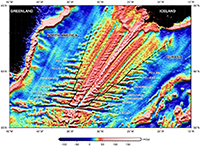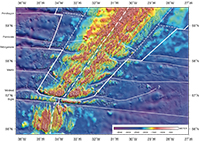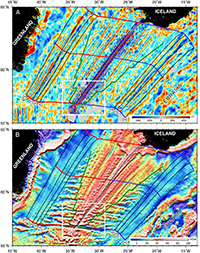
Earth's Fastest Spreading Ridge
North Atlantic Reorganizaion
Hawaii Institute of Geophysics and Planetology
Active Reorganization of North Atlantic Seafloor Spreading
To determine the active and recent processes in the ongoing reorganization from the previous orthogonal ridge/transform staircase geometry to the present linear, continuous, but oblique spreading Reykjanes Ridge geometry, we surveyed the area surrounding the last remaining transform fault south of Iceland—the Bight transform fault. Our survey, in August–September 2013 on R/V Marcus G. Langseth, covered a transform fault elimination in progress, the first orthogonally spreading segment south of the Bight transform, and the three most recent transform eliminations along the obliquely-spreading Reykjanes Ridge. The recent reorganization pattern we mapped shows that previous thermal and propagating rift models are inadequate and suggests a new model for how the reorganization occurs. Tectonic reconfigurations take place within the wide plate boundary zone that characterizes the slow-spreading Reykjanes Ridge. Small-scale mantle convective instabilities propagate along-axis at rapid rates at the Reykjanes Ridge due to large and systematic regional gradients in mantle properties forming the V-shaped crustal ridges on the flanking seafloor.
The initial results (PDF) from our cruise showed how the previous orthogonal ridge/transform staircase geometry south of Iceland is being progressively changed to the present continuous oblique Reykjanes Ridge spreading geometry as North America–Eurasia transform faults are successively eliminated from north to south. This reorganization is commonly interpreted as a thermal phenomenon, caused by warmer Iceland plume mantle progressively interacting with the ridge, although all other diachronous seafloor spreading reorganizations are thought to result from tectonic rift propagation, which we find evidence of also occurring here. However, in contrast to classic propagating rift reorganizations, all of the Reykjanes Ridge jumps are within the broad plate boundary zone. New marine geophysical data (bathymetry grid available here) covering our reinterpretation of the reorganization tip near 57°N show successive transform eliminations at a propagation velocity of ∼110 km/Myr, ten times the spreading half rate, followed by abrupt reorganization slowing at the Modred transform as it was converted to a migrating non-transform offset.
A new fine-scaled tectonic model (PDF) of the Mid-Atlantic Ridge evolution between 55°55'N and the Bight Transform Fault for the past 6 Ma shows how propagating rifts and possible discrete ridge jumps produced the observed asymmetry in our high-resolution marine magnetic data. The amount of lithosphere transferred between the plates during each propagation event is 2-10 km, within the plate boundary zone, and the propagators identified are short-lived (0.5-4.0 Ma). Most of the propagation in the area is to the north and all but two propagators transfer lithosphere from the Eurasian plate to the North American plate, which is consistent with the overall eastward relocation of the Reykjanes Ridge seen on Iceland.
Neither the simple thermal model nor the simple propagating rift model appears adequate to explain the entire complicated plate boundary reorganization process, so we propose a new conceptual model (PDF) for the kinematic evolution of the Reykjanes Ridge and the geodynamic processes involved. Magnetic anomaly data show that orthogonally spreading and offset ridge segments first migrate laterally to reduce segment offsets. Longer segments then break up into smaller segments to better align to a linear oblique axis. The process culminates with a linear but now oblique plate boundary zone formed by en echelon axial volcanic ridges that have retained their nearly spreading-orthogonal geometry throughout the reconfiguration. Plate boundary reconstructions show that the linear Reykjanes Ridge axis today is within about 3° of the orientation and directly over the position of the ancestral initial unsegmented spreading center despite a ∼30° change in opening direction and intervening fragmentation of the axis. This geometric alignment suggests that the deep linear buoyant mantle upwelling zone generated by the initial spreading center persisted even after the axis became segmented and controlled its subsequent reconfiguration back to its original geometry. We propose that sub-axial cells of buoyant mantle upwelling initiate near Iceland and propagate southward driven by gradients in mantle properties (water content/temperature/composition). MBA patterns (grid available here) indicate that propagation of buoyant mantle upwelling replaces the previous orthogonal crustal segmentation forming bulls-eye lows with more uniform long wavelength advection. Cells of propagating sub-axial buoyant mantle upwelling can also generate locally increased crustal thickness and explain the V-shaped ridges flanking the linear Reykjanes Ridge. By changing the pattern of mantle advection, removal of segmentation in itself increases melt production and crustal thickness without changes in mantle temperature. Thus crustal features and tectonic reconfigurations of the Reykjanes Ridge are not necessarily indicators of mantle plume flow or temperature variations in the mantle. Buoyantly upwelling mantle material flows primarily vertically and is then frozen into ridge flank lithosphere with only the temporal locus of the instabilities moving rapidly along-axis. Thus extremely high mantle upwelling and lateral flow velocities are not implied as in “pulsing plume” models and there is no need to invoke an Iceland-specific mantle dehydration layer to deflect rapidly upwelling mantle beneath Iceland and avoid unrealistic crustal thicknesses. There is clearly a mantle melting anomaly in the North Atlantic centered near Iceland and our data and model do not directly address the nature of this anomaly or the existence of a mantle plume. However, the new geophysical data indicate that the tectonic reorganizations of the Reykjanes Ridge and its flanking V-shaped ridges can be better explained by kinematic and plate boundary processes rather than deep mantle plume flow.
During the expedition, a realtime website was maintained by Deb Eason. The participants, their daily blogs, and various links can be viewed there.
Publications
- Hey, R.N., Tectonics: Propagating Rifts and Microplates at Mid-Ocean Ridges, www.sciencedirect.com/science/article/pii/B978012409548903027X, in Elsevier’s Science Direct online Reference Module in Earth Systems and Environmental Sciences, ed. S. Elias, ISBN: 978-0-12-409548-9, 2015.
- Hey, R., F. Martinez, Á. Höskuldsson, D.E. Eason, J. Sleeper, S. Thordarson, Á. Benediktsdóttir, and S. Merkuryev, Multibeam investigation of the active North Atlantic plate boundary reorganization tip, Earth Planet. Sci. Lett., 435, 115-123, dx.doi.org/10.1016/j.epsl.2015.12.019, 2016.
- Benediktsdóttir, Á., R. Hey, F. Martinez, and Á. Höskuldsson, A new kinematic model of the Mid-Atlantic Ridge between 55°55'N and the Bight Transform Fault for the past 6 Ma, J. Geophys. Res. Solid Earth, 121, 455–468, doi:10.1002/2015JB012504, 2016.
- Hey, R., F. Martinez, Á. Höskuldsson, D.E. Eason, J. Sleeper, S. Thordarson, Á. Benediktsdóttir, and S. Merkuryev, Marine geophysical survey of the active Reykjanes Ridge reorganization tip – Implications for the radially expanding Iceland plume model, www.mantleplumes.org/RR_Reorg.html, 2016.
- Martinez, F., and R. Hey, Propagating buoyant mantle upwelling on the Reykjanes Ridge, Earth Planet. Sci. Lett., 457, 10-22, dx.doi.org/10.1016/j.epsl.2016.09.057, 2017.
- R. Hey, The 7% Solution — Cleaning Up After Fred Vine’s Outstanding Successes, Eos Trans. AGU, 94, Fall Meet. Suppl., GP11A-04, 2013.
- F. Martinez, Hey, R., and Hoskuldsson, A. (2014), Reykjanes Ridge evolution and the elimination of transform faults in the North Atlantic, Geophysical Research Abstracts, 16, (EGU 2014 General Assembly, Vienna, Austria), EGU2014-9939.
- Hoskuldsson, A., Martinez, F., and Hey R (2014) Off rift and on rift volcanism along the southern most extremity of the Reykjanes Ridge, Geophysical Research Abstracts 16, European Geosciences Union General Assembly, Vienna, Austria, Abstract EGU2014-12442.
- Benediktsdottir, A., Hey, R., Martinez, F., and Hoskuldsson, A. (2014), The tectonic evolution of the Mid-Atlantic Ridge between 55°55'N and the Bight Transform Fault during the past 6 Ma, AGU Fall Meeting, San Francisco, CA, Abstract GP23A-3662.
- Martinez, F., Hey, R.N., Eason, D.E., (2015), Plate boundary processes as alternatives to mantle plume effects on the Reykjanes Ridge, V12A-03. Eos Trans. AGU 96, Fall Meeting.
- Martinez, F., R. Hey, (2016) Reykjanes Ridge Evolution: Plate Boundary Processes vs. Mantle Plume Flow, North Atlantic 2016 Workshop, Durham University, UK, www.mantleplumes.org/NAWorkshop/NAWorkshop.html
- Martinez, F., R. Hey, (2016) Formation and Elimination of Segmentation on the Reykjanes Ridge, AGU Fall Meeting, San Francisco, CA, Abstract T33A-3006.
- A Hoskuldsson, R Hey, F Martinez, S Thordarson, A Benediktsdottir, From the Icelandic continental shelf to the deep abyss; a tale of divergent plate boundary, Geophysical Research Abstracts 19, European Geosciences Union General Assembly, Vienna, Austria, Abstract EGU2017-8076
- Á Benediktsdóttir, R Hey, F Martinez, Á Höskulddson, Asymmetric seafloor spreading on the Reykjanes Ridge-influence of the Iceland anomaly?, Geophysical Research Abstracts 19, European Geosciences Union General Assembly, Vienna, Austria, Abstract EGU2017-13115-1
- F Martinez, R Hey (2017) Formation and Elimination of Transform Faults on the Reykjanes Ridge, Geophysical Research Abstracts 19, European Geosciences Union General Assembly, Vienna, Austria, Abstract EGU2017-5790
Oceanographic Expeditions
- ***2013 August-September, EM122, magnetics, and gravity survey of the North Atlantic seafloor spreading reorganization near the Bight transform fault, Reykjavik–Reykjavik, SOEST, University of Hawaii, chief scientist F. Martinez, R/V Marcus G. Langseth.
- *** PI and Virtual Chief Scientist
Students involved in this research
- Ásdís Benediktsdóttir
- Deborah Eason
- Jonathan Sleeper
- Dharmindar Maharaj





